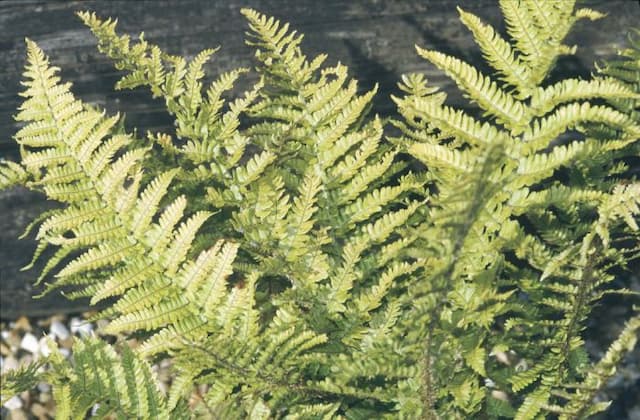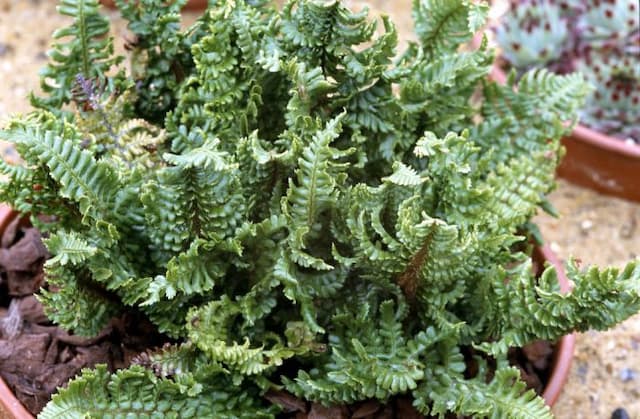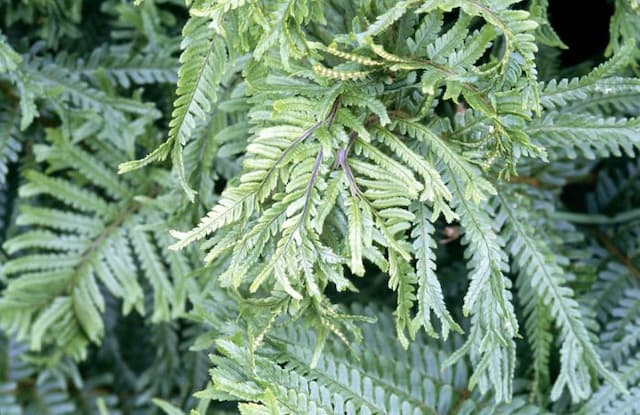Broad buckler fern Dryopteris dilatata











ABOUT
The plant commonly known as the broad buckler fern features attractive foliage that adds a lush, green touch to the spaces it occupies. Its leaves, often referred to as fronds, are divided into smaller leaflets, which spread outwards in a manner that resembles a feather or fern-like structure. These leaflets are arranged in a way that embraces the central stem, progressively becoming smaller towards the top and the base of each frond. The fronds themselves emanate from a central crown, unfurling from coiled buds often described as fiddleheads, due to their resemblance to the scroll of a violin. These fiddleheads can be particularly eye-catching during the early growing season. The color of the fronds is typically a deep green, and they possess a leathery texture that contributes to their robust and hearty appearance. If one were to look closer, the undersides of the fronds reveal a detailed network of veins and, in some cases, small, discrete clusters of spore-producing sori. The layout of these spore clusters can vary, but they often appear as small dots or dashes along the veins. In the wild, the broad buckler fern is often found in clusters that can create a dense layer of vegetation when conditions are ideal. It's a plant that not only stands out due to its intricate leaf patterns and textures but also because it contributes to a rich tapestry of flora in the understory of forests and woodlands.
About this plant
 Names
NamesSynonyms
Broad Buckler-fern, Broad Wood Fern, Dilated Wood Fern, Spreading Wood Fern
Common names
Aspidium dilatatum, Dryopteris austriaca var. dilatata, Dryopteris spinulosa var. dilatata, Lastrea dilatata, Nephrodium dilatatum.
 Characteristics
CharacteristicsLife cycle
Perennials
Foliage type
Deciduous
Color of leaves
Green
Height
3 feet (91 cm)
Spread
2 feet (61 cm)
Plant type
Fern
Hardiness zones
5
Native area
Europe
Benefits
 General Benefits
General Benefits- Erosion Control: Dryopteris dilatata, commonly known as Broad Buckler Fern, helps stabilize soil and prevent erosion in shaded woodland areas.
- Habitat Support: It provides habitat and shelter for various species of insects and small wildlife.
- Aesthetic Appeal: With its lush green foliage, the Broad Buckler Fern is often used in shade gardens for its ornamental value.
- Low Maintenance: This fern is relatively easy to care for, requiring minimal upkeep once established.
- Shade Tolerance: The fern thrives in shady conditions where other plants may struggle, making it ideal for understory planting.
- Companion Planting: It can be planted alongside other shade-loving plants to create a diverse and attractive woodland garden.
 Medical Properties
Medical Properties- This plant is not used for medical purposes.
 Air-purifying Qualities
Air-purifying QualitiesThis plant is not specifically known for air purifying qualities.
 Other Uses
Other Uses- Dye Production: Dryopteris dilatata, commonly known as the broad buckler fern, can be used to produce a green dye when the leaves are boiled with alum.
- Livestock Bedding: The dried fronds of the broad buckler fern can be used as bedding for small animals and poultry due to their softness and absorbency.
- Garden Mulch: The fern can be broken down into mulch to help retain soil moisture, suppress weeds, and add organic matter to garden beds.
- Ferneries: Broad buckler ferns are often used in ferneries for their aesthetic appeal and their ability to thrive in shaded, moist areas.
- Floral Arrangements: Fresh or dried fronds of the broad buckler fern can be used as greenery in floral arrangements for their intricate leaf patterns.
- Protective Ground Cover: The plant can act as a protective ground cover to prevent soil erosion in areas prone to heavy rains or winds.
- Arts and Crafts: The fronds can be used in arts and crafts for making impressions in clay or as a natural material in eco-printing on fabrics.
- Companion Planting: When planted alongside certain garden vegetables, broad buckler ferns may help deter pests with their dense foliage.
- Education and Science: Dryopteris dilatata can serve as a specimen for botanical studies and education about fern life cycles and reproduction.
- Habitat Restoration: The fern can be used in woodland restoration projects to help recreate native understory habitats within forest ecosystems.
Interesting Facts
 Feng Shui
Feng ShuiThe Broad Buckler Fern is not used in Feng Shui practice.
 Zodiac Sign Compitability
Zodiac Sign CompitabilityThe Broad Buckler Fern is not used in astrology practice.
 Plant Symbolism
Plant Symbolism- Shielding: Known as the Broad Buckler Fern, this plant's widespread fronds resemble a buckler or shield, symbolizing protection and defense.
- Endurance: The fern's capacity to thrive in various climates and conditions is indicative of resilience and the ability to persist through difficulties.
- Secretiveness: In Victorian times, ferns were associated with solitude and confidentiality, due to their preference for secluded places in the wild, conveying a sense of mystery and discretion.
- Reverie: Its elegant and intricate leaves can symbolize a fascination with dreams and the unconscious, as ferns have often been connected to enchantment and the otherworldly.
 Water
WaterThe Broad Buckler-fern should be watered deeply but allowing the soil to become almost dry between waterings. Typically, water the plant with about 1 gallon of water every week during the growing season, reducing the amount during winter when the plant's growth slows down. Ensure that the water penetrates the soil well without leaving standing water, as this can lead to root rot.
 Light
LightThe Broad Buckler-fern thrives best in partial shade to full shade conditions. It should be placed in a spot where it is shielded from direct sunlight, which can scorch its fronds. A north-facing windowsill or a shady corner in a garden are ideal spots for this fern, where it can receive indirect or filtered light.
 Temperature
TemperatureThe Broad Buckler-fern prefers a cool to moderate temperature range, ideally between 60 to 75 degrees Fahrenheit. The plant can survive minimum temperatures down to approximately 50 degrees Fahrenheit but should be protected from both freezing conditions and extreme heat to prevent damage.
 Pruning
PruningPruning the Broad Buckler-fern is generally done to remove dead or damaged fronds and to maintain its attractive shape. Pruning should be carried out in the spring, just before new growth begins. It's typically sufficient to prune once a year, cutting back any old fronds to the base to make way for the new growth.
 Cleaning
CleaningAs needed
 Soil
SoilBroad buckler fern, Dryopteris dilatata, thrives best in a soil mix that is rich in organic matter with good drainage. A mixture of loamy garden soil, peat, and perlite or coarse sand is ideal to ensure proper moisture retention while avoiding waterlogging. The best soil pH for broad buckler fern is slightly acidic to neutral, ranging from 5.5 to 7.0.
 Repotting
RepottingBroad buckler fern should be repotted every 2 to 3 years. It's best to repot in the spring just before the growing season begins. Choose a pot that is slightly larger than the current one as this plant does not require an excessive amount of space to thrive.
 Humidity & Misting
Humidity & MistingBroad buckler fern prefers a high humidity environment. The ideal humidity level for this plant ranges from 60% to 70%. It is important to maintain consistent humidity to prevent the fronds from drying out.
 Suitable locations
Suitable locationsIndoor
Keep broad buckler fern in shade, high humidity, moist soil.
Outdoor
Place in partial shade, moist soil, protect from wind.
Hardiness zone
4-8 USDA
 Life cycle
Life cycleThe Broad buckler-fern (Dryopteris dilatata) begins its life cycle as a spore released from mature ferns. These spores germinate in moist, shady conditions to form a gametophyte, which is a small, heart-shaped plant structure. The male and female sex organs develop on the gametophyte, and following fertilization, a zygote is formed. From the zygote, a young fern called a sporophyte emerges, initially as a tiny fiddlehead that unfurls its leaves as it grows. The sporophyte matures and develops sori on the undersides of its fronds, which are clusters of sporangia where spores are produced. When the spores are ripe, they are released to start a new cycle, completing the life stages of the Broad buckler-fern.
 Propogation
PropogationPropogation time
Spring to Summer
Propogation: The Broad Buckler Fern, Dryopteris dilatata, is typically propagated through spores, which are generally collected in late summer. To propagate by spores, it is important to mimic the natural conditions under which fern spores germinate. A common method involves sowing the spores on the surface of a sterilized soil mix comprised of equal parts peat and sand or a peat-substitute and perlite. This should be kept moist and in a warm (around 68 to 72 degrees Fahrenheit or 20 to 22 degrees Celsius) and bright, but not directly sunlit, environment. The surface of the mixture should not be disturbed to prevent the tiny spores from being buried. In favorable conditions, spores will germinate to form a green film of gametophytes, from which the new ferns will eventually develop, a process that can take several months to over a year.









